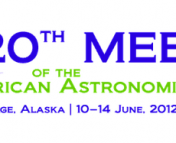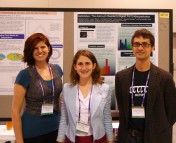Astrobites is again liveblogging AAS! In order to avoid inundating our readers’ RSS feeds, we’ll be updating this post with short paragraphs about the talks we’ve heard and posters we’ve seen. So keep checking back throughout Monday morning!
– Chris Faesi, Susanna Kohler and Lauren Weiss
10:00 am Press Conference: What’s New Under the Sun
This conference covered a few of the latest press releases related to solar physics. Among them was a discussion by Nicola Omodei (Stanford University) of the Fermi LAT observations of the March 7 class X5.4 solar flare, which was bright in the high-energy gamma-ray band in which Fermi observes. These observations localized the flare and helped inform models of the cause of the energetic emission. Dibyendy Nandy (Indian Institute of Science Education & Research) discussed recent work indicating that the amplitude of each 11-year solar cycle is dependent only upon properties of the cycle immediately previous to it, inspiring his talk title “The Sun Has a Short Memory.” Michael Hahn (Columbia University) presented a new potential solution for the coronal heating problem (how is it that the solar surface is only 6,000K and the solar corona above it is 1,000,000K?). His proposed explanation uses observations that demonstrate energy loss in MHD waves within a polar coronal hole, suggesting that these waves deposit energy at low heights in the corona and thereby cause coronal heating.
8:30 am Kavli Prize Talk – Ewine F. van Dishoeck (Sterrewacht Leiden, Netherlands)
Ewine took this opportunity to remind us of the importance of laboratory astrophysics in modeling and interpreting astrophysical data. Laboratory astrophysics, which involves simulating the material conditions of space in a laboratory setting, helps us understand how the light (especially spectra) we collect in telescopes can teach us about the materials (atomic and molecular) it encountered on its journey. Ewine gave an extensive historical overview of laboratory astrophysics’ role in many sub-fields of astronomy (including the discovery of neutrino oscillations that solved the solar neutrino problem), but eventually focussed on how laboratory astrophysics has informed star and planet formation. For instance, what does the spectrum of an icy dust grain that formed in the disk of material around a star look like? Laboratory astrophysicists build such dust grains and measure their spectra. These measurements then get incorporated into detailed modeling codes that observers use when characterizing the material around stars. Thus, the discoveries of shocked water in jets emanating from stars, and of hydrogen peroxide as a key ingredient in the formation of water, are rooted in controlled laboratory experiments. Ewine emphasized that we can help secure funding for laboratory astrophysics by citing the papers of such experiments directly, in addition to citing the well-cited modeling codes that were built from the results of these experiments.
8:00am – Welcome Address
The 220th Meeting of the AAS in Anchorage, AK kicked off bright and early with a welcome from the University of Alaska – Anchorage Chancellor Tom Case and from AAS President Debra Elmegreen. The opening ceremonies also included a surprise performance by a trio of local Alaskan drummers and dancers, who welcomed attendees with a wonderful short program of music, vocals, and dance. Have a listen here: Alaskan Drummers. The AAS also announced the addition of a new Division, the first added to the Society in over 30 years: the Laboratory Astrophysics Division. There are now six Divisions, each of which covers a “nontraditional” subfield of astronomy. The other five are High-Energy Astrophysics, Historical Astronomy, Solar Physics, Dynamical Astronomy, and Planetary Sciences.







Trackbacks/Pingbacks